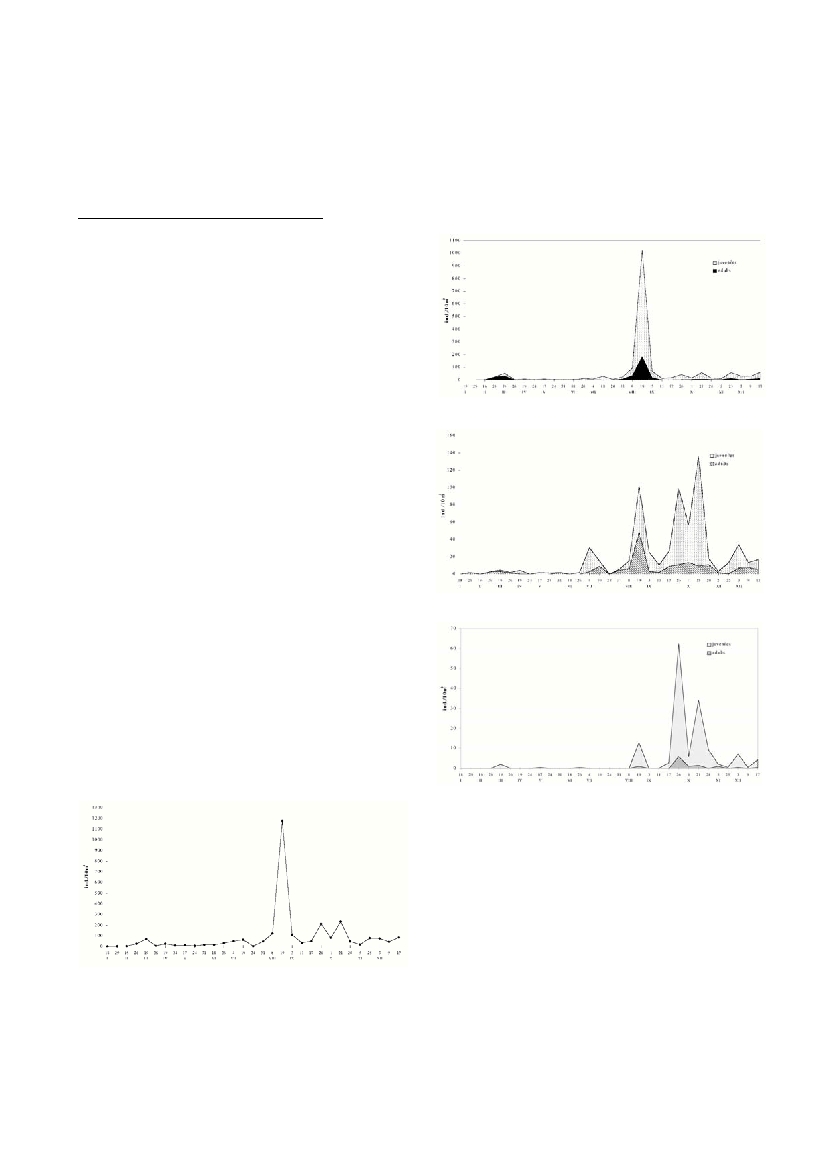Rapp. Comm. int. Mer Médit., 36,2001
236
Introduction
Existing data on thecosome pteropod in the Adriatic Sea are scarce. The
available literature regards mostly species composition and horizontal dis-
tribution (1,2). This paper presents the composition and weekly variation
in abundance of thecosome pteropods over a one year period in the coastal
waters of Dubrovnik.
Material and methods
The plankton samples were collected at a station located 1/2 Nm
southwest of the island Lokrum near Dubrovnik in time intervals of 1-
3 weeks during 1996. Samples were taken by vertical hauls at depth of
75-0 m, using a Nansen net with a 200 µm mesh size. The planktonic
material was preserved with a 2.5 % formaldehyde solution.
Results and discussion
At the Lokrum station 12 species of thecosome pteropods were
identified.Limacina in?ata, L. trochiformis, L. bulimoides, Styliola
subula, Creseis virgula, C. acicula, Hyalocylix striata, Clio pyramida-
ta, Cavolinia in?exa, Peracilis reticulata i Cymbulia peronihave been
reported previously (1, 2) while Desmopterus papilio has been regis-
tered for the first time in the Adriatic. This species is common in trop-
ical areas of the Atlantic and in the Indian Ocean (1). Contrarily, it is
rare in the Mediterranean and has been registered only in the western
basin (3, 4), which indicates its probable immigration to the Adriatic
by way of the Red Sea.
The total number of thecosome pteropods were higher in the latter
half of the year (Fig. 1) that coincidence with earlier research (2). A
marked increase in numbers (1171 ind./10m
3
) was recorded in mid-
August, then decrease rapidly at the beginning of September.
Limacina in?atamade 87% of total thecosome pteropods count
(Fig.2). On the contrary, in the Mediterranean, this species has its low-
est density during summer, and its maximum mainly from autumn to
spring (1). Except L. in?ata, the most numerous species were Creseis
virgulaandC. acicula.The highest numbers of C. virgula(136
ind./10m
3
) were recorded at the end of October, and for C. acicula
(62ind./10m
3
) at the end of September (Fig. 3, Fig. 4). In the
Mediterranean Sea C. virgulais numerous, but the seasonal distribu-
tion in density varies in certain areas (1,5). Also, the density and fre-
quency of the C. aciculaare irregular and coherent ecological rules are
difficult to determine (1).
All three species reproduce intensely during the summer-autumn
period, according to the distribution of juvenile specimens throughout
the year (Fig. 2, Fig. 3, Fig. 4). In the Mediterranean Sea L. in?ata
reproduce intensely from autumn to spring, the C. virgulafrom
autumn to winter, and there is no rules for the C. acicula(1).
Fig. 1. Abundance of total thecosome pteropods at the station
Lokrum during 1996.
Fig. 2. Abundance of Limacina in?ataat the station Lokrum
during 1996.
Fig. 3. Abundance of Creseis virgulaat the station Lokrum dur-
ing 1996.
Fig. 4. Abundance of Creseis aciculaat the station Lokrum dur-
ing 1996.
References
1 - Rampal J., 1975. Les Thécosomes (Mollusques pélagiques).
Systématique et évolution - Écologie et biogéographie méditerranéennes.
Tesis doctoral. Université Aix-Marseille I, p. 485.
2 - Gamulin T., 1979. Zooplankton isto_ne obale Jadranskog mora. Acta
Biol., 8: 177-270.
3 - Meisenheimer J., 1905. Pteropoda. Wiss Ergebn. d. Tiefsee-Exped.
"Valvidia"9, p. 314.
4 - Franc A., 1949. Hétéropodes et autres Gastéropodes planctoniques de
Méditerranée Occidentale.J. Conchyliol., 89: 209-230.
5 - Menzies R. J., 1958. Shell-bearing pteropod gastropods from
Mediterranean plankton (Cavoliniidae).Pubbl. Staz. Zool. Napoli30 (3):
A
N
N
UAL VARIABILITY OF THECOSOME PTEROPOD POPULATION DENSITIES IN THE SOUTH A
D
R
I
AT
I
C
Mirna Batistic
Institute of Oceanography and Fisheries, Laboratory of Plankton Ecology, Dubrovnik, Croatia - mirna.batistic@labdu.izor.hr
Abstract
The composition and abundance of thecosome pteropods were investigated by taking weekly samplings at the station near Dubrovnik
during 1996. Twelve species were identified. Desmopterus papiliowas registered for the first time in the Adriatic. The highest density of
pteropods (1171 ind./10m
3
) was recorded in mid-August, while the lowest density (1 ind./10m
3
) occurred in mid-January.Limacina
in?ata,Creseis virgulaandC. aciculaaccounting more than 85% of the overall pteropod counts. Intensive reproduction occurred in the
summer-autumn period for all three species.
Keywords: Zooplankton, Pteropod, Adriatic Sea.

